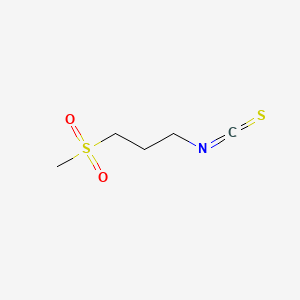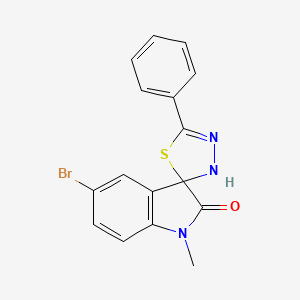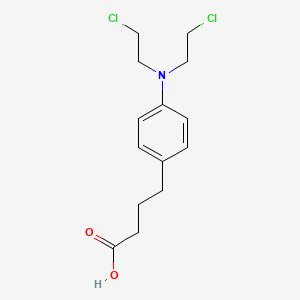
Chlorambucil
Übersicht
Beschreibung
Chlorambucil ist ein Chemotherapeutikum, das hauptsächlich zur Behandlung von chronisch-lymphatischer Leukämie, Hodgkin-Lymphom und Non-Hodgkin-Lymphom eingesetzt wird . Es gehört zur Klasse der Stickstoff-Lost-Alkylierungsmittel, die durch Interferenz mit dem DNA-Replikationsprozess in Krebszellen wirken . This compound ist bekannt für sein relativ mildes Nebenwirkungsprofil im Vergleich zu anderen Alkylierungsmitteln, was es zu einer bevorzugten Wahl für bestimmte Patientengruppen macht .
2. Herstellungsmethoden
Synthesewege und Reaktionsbedingungen: this compound wird in einem mehrstufigen Prozess synthetisiert, der von 4-Aminophenylbuttersäure ausgeht. Die Reaktionsbedingungen umfassen typischerweise die Verwendung von Lösungsmitteln wie Dichlormethan und Katalysatoren wie Triethylamin, um die Alkylierungsreaktionen zu erleichtern .
Industrielle Produktionsmethoden: In industriellen Umgebungen beinhaltet die Produktion von this compound die großtechnische Synthese unter Verwendung ähnlicher Reaktionswege, die jedoch auf höhere Ausbeuten und Reinheit optimiert sind. Der Prozess umfasst strenge Reinigungsschritte wie Umkristallisation und Chromatographie, um sicherzustellen, dass das Endprodukt pharmazeutische Standards erfüllt .
Wirkmechanismus
Target of Action
Chlorambucil is a nitrogen mustard alkylating agent . It primarily targets DNA, where it interferes with DNA replication and damages the DNA in a cell .
Mode of Action
This compound works by blocking the formation of DNA and RNA . It forms covalent bonds with DNA, leading to the formation of intrastrand and interstrand cross-links. These cross-links prevent DNA from being properly replicated, which in turn inhibits the proliferation of rapidly dividing cancer cells .
Biochemical Pathways
It is known that this compound can induce apoptosis, or programmed cell death, in cancer cells . This is likely due to the DNA damage caused by the drug, which can trigger cellular stress responses leading to apoptosis .
Pharmacokinetics
This compound is extensively metabolized in the liver, primarily to phenylacetic acid mustard . The pharmacokinetic data suggests that oral this compound undergoes rapid gastrointestinal absorption and plasma clearance . It is almost completely metabolized, having extremely low urinary excretion . The mean distribution half-life of this compound is 0.49 hr and the terminal elimination half-life is 2.45 hr .
Result of Action
The primary result of this compound’s action is the inhibition of cancer cell proliferation. By damaging DNA and preventing its replication, this compound can effectively slow or stop the growth of cancer cells . This can lead to a reduction in the size of tumors and a slowing of disease progression .
Action Environment
Environmental factors can influence the action, efficacy, and stability of this compound. For example, the drug’s bioavailability and therapeutic outcomes can be improved through the use of nanoformulations . Additionally, this compound is soluble in ethanol, chloroform, ethyl acetate, benzene, and ether, and readily soluble in acid or alkaline solutions , which can impact its stability and efficacy.
Biochemische Analyse
Biochemical Properties
Chlorambucil interacts with various biomolecules, primarily DNA, to exert its effects . It forms covalent bonds with DNA, leading to the formation of mono- or bifunctional adducts . These adducts interfere with gene expression and promote mismatched base-pairing, while bifunctional alkylation creates intra- and interstrand cross-links that inhibit DNA synthesis and cause double-strand breaks .
Cellular Effects
This compound has profound effects on various types of cells and cellular processes. It interferes with DNA replication and damages the DNA in a cell . This DNA damage induces cell cycle arrest and cellular apoptosis via the accumulation of cytosolic p53 and subsequent activation of Bcl-2-associated X protein, an apoptosis promoter .
Molecular Mechanism
This compound exerts its effects at the molecular level by blocking the formation of DNA and RNA . It alkylates and cross-links DNA during all phases of the cell cycle, inducing DNA damage via three different methods of covalent adduct generation with double-helical DNA .
Temporal Effects in Laboratory Settings
This compound demonstrates a monophasic disappearance from plasma, with a half-life of 26 minutes . The bioavailability of this compound decreases further when 4-day treatment cycles are repeated .
Dosage Effects in Animal Models
In animal models, the effects of this compound vary with different dosages . For instance, in dogs, the dosage ranges from 2-6 mg/m2, depending on the condition being treated . In cats, the dosage is typically 2 mg/m2 every 48 hours or 20 mg/m2 every two weeks .
Metabolic Pathways
This compound is extensively metabolized in the liver primarily to phenylacetic acid mustard . The pharmacokinetic data suggests that oral this compound undergoes rapid gastrointestinal absorption and plasma clearance and that it is almost completely metabolized, having extremely low urinary excretion .
Transport and Distribution
This compound is given orally and is rapidly absorbed in the gastrointestinal tract . It is extensively metabolized in the liver, primarily to phenylacetic acid mustard . The pharmacokinetic data suggests that this compound undergoes rapid gastrointestinal absorption and plasma clearance .
Subcellular Localization
This compound localizes to cancer cell mitochondria where it acts on mtDNA to arrest cell cycle and induce cell death . This localization to the mitochondria is significant as it enhances the cell-killing effect of this compound in a panel of breast and pancreatic cancer cell lines .
Vorbereitungsmethoden
Synthetic Routes and Reaction Conditions: Chlorambucil is synthesized through a multi-step process starting from 4-aminophenylbutyric acid. The reaction conditions typically involve the use of solvents like dichloromethane and catalysts such as triethylamine to facilitate the alkylation reactions .
Industrial Production Methods: In industrial settings, the production of this compound involves large-scale synthesis using similar reaction pathways but optimized for higher yields and purity. The process includes rigorous purification steps such as recrystallization and chromatography to ensure the final product meets pharmaceutical standards .
Analyse Chemischer Reaktionen
Arten von Reaktionen: Chlorambucil unterliegt verschiedenen Arten von chemischen Reaktionen, darunter:
Oxidation: this compound kann zu verschiedenen Metaboliten oxidiert werden, hauptsächlich in der Leber.
Reduktion: Obwohl seltener, können Reduktionsreaktionen unter bestimmten Bedingungen auftreten.
Häufige Reagenzien und Bedingungen:
Oxidation: Häufige Oxidationsmittel sind Wasserstoffperoxid und Kaliumpermanganat.
Substitution: Nucleophile wie Thiole und Amine werden häufig in Substitutionsreaktionen verwendet.
Hauptprodukte, die gebildet werden: Die Hauptprodukte, die aus diesen Reaktionen entstehen, sind DNA-Addukte, die für die Antikrebsaktivität der Verbindung verantwortlich sind .
Wissenschaftliche Forschungsanwendungen
Chlorambucil hat eine breite Palette von Anwendungen in der wissenschaftlichen Forschung:
Industrie: Die Verbindung wird bei der Entwicklung neuer Arzneimittelformulierungen und -abgabesysteme verwendet.
5. Wirkmechanismus
This compound übt seine Wirkungen aus, indem es DNA-Stränge vernetzt, wodurch die DNA-Replikation und -Transkription verhindert werden . Dies führt zu einem Zellzyklusarrest und Apoptose in schnell teilenden Krebszellen . Die primären molekularen Ziele sind die Guaninbasen in der DNA, an denen this compound kovalente Bindungen bildet . Dieser Mechanismus stört die normale Funktion der DNA, was zum Zelltod führt .
Ähnliche Verbindungen:
Cyclophosphamid: Ein weit verbreitetes Alkylierungsmittel mit Anwendungen bei verschiedenen Krebsarten und Autoimmunerkrankungen.
Einzigartigkeit von this compound: this compound ist einzigartig aufgrund seines relativ milden Nebenwirkungsprofils und seiner oralen Verabreichungsform, was es für Patienten bequemer macht . Darüber hinaus bietet sein spezifisches Alkylierungsmuster einen einzigartigen Wirkmechanismus im Vergleich zu anderen Alkylierungsmitteln .
Vergleich Mit ähnlichen Verbindungen
Melphalan: Another nitrogen mustard alkylating agent used in the treatment of multiple myeloma and ovarian cancer.
Cyclophosphamide: A widely used alkylating agent with applications in various cancers and autoimmune diseases.
Ifosfamide: Similar to cyclophosphamide but with a different metabolic pathway and used in different cancer types.
Uniqueness of Chlorambucil: this compound is unique due to its relatively mild side effect profile and oral administration route, making it more convenient for patients . Additionally, its specific alkylation pattern provides a distinct mechanism of action compared to other alkylating agents .
Eigenschaften
IUPAC Name |
4-[4-[bis(2-chloroethyl)amino]phenyl]butanoic acid | |
|---|---|---|
| Source | PubChem | |
| URL | https://pubchem.ncbi.nlm.nih.gov | |
| Description | Data deposited in or computed by PubChem | |
InChI |
InChI=1S/C14H19Cl2NO2/c15-8-10-17(11-9-16)13-6-4-12(5-7-13)2-1-3-14(18)19/h4-7H,1-3,8-11H2,(H,18,19) | |
| Source | PubChem | |
| URL | https://pubchem.ncbi.nlm.nih.gov | |
| Description | Data deposited in or computed by PubChem | |
InChI Key |
JCKYGMPEJWAADB-UHFFFAOYSA-N | |
| Source | PubChem | |
| URL | https://pubchem.ncbi.nlm.nih.gov | |
| Description | Data deposited in or computed by PubChem | |
Canonical SMILES |
C1=CC(=CC=C1CCCC(=O)O)N(CCCl)CCCl | |
| Source | PubChem | |
| URL | https://pubchem.ncbi.nlm.nih.gov | |
| Description | Data deposited in or computed by PubChem | |
Molecular Formula |
C14H19Cl2NO2 | |
| Record name | CHLORAMBUCIL | |
| Source | CAMEO Chemicals | |
| URL | https://cameochemicals.noaa.gov/chemical/16180 | |
| Description | CAMEO Chemicals is a chemical database designed for people who are involved in hazardous material incident response and planning. CAMEO Chemicals contains a library with thousands of datasheets containing response-related information and recommendations for hazardous materials that are commonly transported, used, or stored in the United States. CAMEO Chemicals was developed by the National Oceanic and Atmospheric Administration's Office of Response and Restoration in partnership with the Environmental Protection Agency's Office of Emergency Management. | |
| Explanation | CAMEO Chemicals and all other CAMEO products are available at no charge to those organizations and individuals (recipients) responsible for the safe handling of chemicals. However, some of the chemical data itself is subject to the copyright restrictions of the companies or organizations that provided the data. | |
| Source | PubChem | |
| URL | https://pubchem.ncbi.nlm.nih.gov | |
| Description | Data deposited in or computed by PubChem | |
DSSTOX Substance ID |
DTXSID7020263 | |
| Record name | Chlorambucil | |
| Source | EPA DSSTox | |
| URL | https://comptox.epa.gov/dashboard/DTXSID7020263 | |
| Description | DSSTox provides a high quality public chemistry resource for supporting improved predictive toxicology. | |
Molecular Weight |
304.2 g/mol | |
| Source | PubChem | |
| URL | https://pubchem.ncbi.nlm.nih.gov | |
| Description | Data deposited in or computed by PubChem | |
Physical Description |
Chlorambucil appears as white to pale beige crystalline or granular powder with a slight odor. Melting point 65-69 °C., Solid | |
| Record name | CHLORAMBUCIL | |
| Source | CAMEO Chemicals | |
| URL | https://cameochemicals.noaa.gov/chemical/16180 | |
| Description | CAMEO Chemicals is a chemical database designed for people who are involved in hazardous material incident response and planning. CAMEO Chemicals contains a library with thousands of datasheets containing response-related information and recommendations for hazardous materials that are commonly transported, used, or stored in the United States. CAMEO Chemicals was developed by the National Oceanic and Atmospheric Administration's Office of Response and Restoration in partnership with the Environmental Protection Agency's Office of Emergency Management. | |
| Explanation | CAMEO Chemicals and all other CAMEO products are available at no charge to those organizations and individuals (recipients) responsible for the safe handling of chemicals. However, some of the chemical data itself is subject to the copyright restrictions of the companies or organizations that provided the data. | |
| Record name | Chlorambucil | |
| Source | Human Metabolome Database (HMDB) | |
| URL | http://www.hmdb.ca/metabolites/HMDB0014436 | |
| Description | The Human Metabolome Database (HMDB) is a freely available electronic database containing detailed information about small molecule metabolites found in the human body. | |
| Explanation | HMDB is offered to the public as a freely available resource. Use and re-distribution of the data, in whole or in part, for commercial purposes requires explicit permission of the authors and explicit acknowledgment of the source material (HMDB) and the original publication (see the HMDB citing page). We ask that users who download significant portions of the database cite the HMDB paper in any resulting publications. | |
Solubility |
>45.6 [ug/mL] (The mean of the results at pH 7.4), less than 0.1 mg/mL at 72 °F (NTP, 1992), Insoluble in water ... The sodium salt is soluble in water., The free acid is soluble at 20 °C in 1.5 parts ethanol, 2 parts acetone, 2.5 parts chloroform and 2 parts ethyl acetate; soluble in benzene and ether. Readily soluble in acid or alkali., 7.73e-02 g/L | |
| Record name | SID855863 | |
| Source | Burnham Center for Chemical Genomics | |
| URL | https://pubchem.ncbi.nlm.nih.gov/bioassay/1996#section=Data-Table | |
| Description | Aqueous solubility in buffer at pH 7.4 | |
| Record name | CHLORAMBUCIL | |
| Source | CAMEO Chemicals | |
| URL | https://cameochemicals.noaa.gov/chemical/16180 | |
| Description | CAMEO Chemicals is a chemical database designed for people who are involved in hazardous material incident response and planning. CAMEO Chemicals contains a library with thousands of datasheets containing response-related information and recommendations for hazardous materials that are commonly transported, used, or stored in the United States. CAMEO Chemicals was developed by the National Oceanic and Atmospheric Administration's Office of Response and Restoration in partnership with the Environmental Protection Agency's Office of Emergency Management. | |
| Explanation | CAMEO Chemicals and all other CAMEO products are available at no charge to those organizations and individuals (recipients) responsible for the safe handling of chemicals. However, some of the chemical data itself is subject to the copyright restrictions of the companies or organizations that provided the data. | |
| Record name | Chlorambucil | |
| Source | DrugBank | |
| URL | https://www.drugbank.ca/drugs/DB00291 | |
| Description | The DrugBank database is a unique bioinformatics and cheminformatics resource that combines detailed drug (i.e. chemical, pharmacological and pharmaceutical) data with comprehensive drug target (i.e. sequence, structure, and pathway) information. | |
| Explanation | Creative Common's Attribution-NonCommercial 4.0 International License (http://creativecommons.org/licenses/by-nc/4.0/legalcode) | |
| Record name | CHLORAMBUCIL | |
| Source | Hazardous Substances Data Bank (HSDB) | |
| URL | https://pubchem.ncbi.nlm.nih.gov/source/hsdb/3026 | |
| Description | The Hazardous Substances Data Bank (HSDB) is a toxicology database that focuses on the toxicology of potentially hazardous chemicals. It provides information on human exposure, industrial hygiene, emergency handling procedures, environmental fate, regulatory requirements, nanomaterials, and related areas. The information in HSDB has been assessed by a Scientific Review Panel. | |
| Record name | Chlorambucil | |
| Source | Human Metabolome Database (HMDB) | |
| URL | http://www.hmdb.ca/metabolites/HMDB0014436 | |
| Description | The Human Metabolome Database (HMDB) is a freely available electronic database containing detailed information about small molecule metabolites found in the human body. | |
| Explanation | HMDB is offered to the public as a freely available resource. Use and re-distribution of the data, in whole or in part, for commercial purposes requires explicit permission of the authors and explicit acknowledgment of the source material (HMDB) and the original publication (see the HMDB citing page). We ask that users who download significant portions of the database cite the HMDB paper in any resulting publications. | |
Mechanism of Action |
Alkylating agents work by three different mechanisms: 1) attachment of alkyl groups to DNA bases, resulting in the DNA being fragmented by repair enzymes in their attempts to replace the alkylated bases, preventing DNA synthesis and RNA transcription from the affected DNA, 2) DNA damage via the formation of cross-links (bonds between atoms in the DNA) which prevents DNA from being separated for synthesis or transcription, and 3) the induction of mispairing of the nucleotides leading to mutations., As an alkylating agent, chlorambucil interferes with DNA replication and transcription of RNA, and ultimately results in the disruption of nucleic acid function. In vitro studies have shown that the major metabolite of chlorambucil (phenylacetic acid mustard), which is also a bifunctional alkylating compound, has antineoplastic activity against some neoplastic human cell lines that is approximately equal to that of chlorambucil. Therefore, the major metabolite of chlorambucil may contribute to the in vivo antitumor activity of the drug. Chlorambucil also possesses some immunosuppressive activity, principally due to its suppression of lymphocytes. The drug is the slowest acting and generally least toxic of the presently available nitrogen mustard derivatives., A marked transient increase was observed in ribonucleotide reductase activity within 2 hr of exposing BALB/c 3T3 mouse cells to DNA damaging concentrations of chlorambucil. Elevations in activity were accompanied by transient increases in the mRNA levels of both genes (R1 and R2) that code for ribonucleotide reductase. Only the protein for the limiting component for enzyme activity R2 was significantly elevated in chlorambucil treated cultures. The chlorambucil effects upon activity and regulation of ribonucleotide reductase occurred without any detectable changes in the rate of DNA synthesis, as would be expected if the elevation in enzyme activity is required for DNA repair. The chlorambucil-induced elevations in R1 and R2 message levels were blocked by treatment of cells with actinomycin D or the tumor promoter 12-O-tetradecanoylphorbol-13-acetate indicating the importance of the reductase transcriptional process in responding to the action of chlorambucil and providing evidence for the involvement of a protein kinase C pathway in the regulation of mammalian ribonucleotide reductase. In addition to the chlorambucil-induced elevations in enzyme activity, message, and protein levels, the drug was also shown to be an inhibitor of ribonucleotide reductase activity in cell-free preparations. Both R1 and R2 proteins were targets for chlorambucil, in keeping with the known alkylating abilities of the drug., /ALTERNATIVE and IN VITRO TESTS/ Reaction of one of the two chloroethyl groups of chlorambucil with the N7 position of guanine or adenine of double-stranded DNA leads to the formation of mono-adducts. These are repaired rapidly in an error-free fashion by methylguanine methyltransferase (sometimes called alkylguanine alkyltransferase). However, some cells lack this repair activity, usually because of silencing of the corresponding gene, and the unrepaired DNA mono-adduct then forms a complex with mismatch-repair enzymes. The subsequent inhibition of DNA replication can eventually induce DNA breakage. The second chloroethyl group of the DNA mono-adduct with chlorambucil can interact with proteins but more importantly, because of its juxtaposition to other bases in the major groove of DNA, it can react with a DNA base to form an interstrand DNA cross-link. This DNA crosslink complex is quite stable, and its repair requires nucleotide excision repair factors (such as xeroderma pigmentosum complementation group F-excison repair cross-complementing rodent repair deficiency, complementation group, 1-XPF-ERCC1) that act slowly by homologous recombination. The DNA cross-link attracts several binding proteins, probably the BRCA1 and BRCA2 proteins, Fanconi anemia gene product, and Nijmegen breakage syndrome gene product to form a complex. As shown in cultured HeLa cells, addition of chlorambucil prolongs S-phase and induces a corresponding mitotic delay. The magnitude of these effects correlates with the level of DNA cross-links. Treatment of cells in the G2-phase of the cell cycle does not induce mitotic delay but does inhibit DNA synthesis in the subsequent cell cycle, and causes a delay in the next mitosis, suggesting that at least some lesions induced by chlorambucil are long-lasting. | |
| Record name | Chlorambucil | |
| Source | DrugBank | |
| URL | https://www.drugbank.ca/drugs/DB00291 | |
| Description | The DrugBank database is a unique bioinformatics and cheminformatics resource that combines detailed drug (i.e. chemical, pharmacological and pharmaceutical) data with comprehensive drug target (i.e. sequence, structure, and pathway) information. | |
| Explanation | Creative Common's Attribution-NonCommercial 4.0 International License (http://creativecommons.org/licenses/by-nc/4.0/legalcode) | |
| Record name | CHLORAMBUCIL | |
| Source | Hazardous Substances Data Bank (HSDB) | |
| URL | https://pubchem.ncbi.nlm.nih.gov/source/hsdb/3026 | |
| Description | The Hazardous Substances Data Bank (HSDB) is a toxicology database that focuses on the toxicology of potentially hazardous chemicals. It provides information on human exposure, industrial hygiene, emergency handling procedures, environmental fate, regulatory requirements, nanomaterials, and related areas. The information in HSDB has been assessed by a Scientific Review Panel. | |
Color/Form |
Off-white, slightly granular powder, Flattened needles from petroleum ether, Fine white crystals | |
CAS No. |
305-03-3 | |
| Record name | CHLORAMBUCIL | |
| Source | CAMEO Chemicals | |
| URL | https://cameochemicals.noaa.gov/chemical/16180 | |
| Description | CAMEO Chemicals is a chemical database designed for people who are involved in hazardous material incident response and planning. CAMEO Chemicals contains a library with thousands of datasheets containing response-related information and recommendations for hazardous materials that are commonly transported, used, or stored in the United States. CAMEO Chemicals was developed by the National Oceanic and Atmospheric Administration's Office of Response and Restoration in partnership with the Environmental Protection Agency's Office of Emergency Management. | |
| Explanation | CAMEO Chemicals and all other CAMEO products are available at no charge to those organizations and individuals (recipients) responsible for the safe handling of chemicals. However, some of the chemical data itself is subject to the copyright restrictions of the companies or organizations that provided the data. | |
| Record name | Chlorambucil | |
| Source | CAS Common Chemistry | |
| URL | https://commonchemistry.cas.org/detail?cas_rn=305-03-3 | |
| Description | CAS Common Chemistry is an open community resource for accessing chemical information. Nearly 500,000 chemical substances from CAS REGISTRY cover areas of community interest, including common and frequently regulated chemicals, and those relevant to high school and undergraduate chemistry classes. This chemical information, curated by our expert scientists, is provided in alignment with our mission as a division of the American Chemical Society. | |
| Explanation | The data from CAS Common Chemistry is provided under a CC-BY-NC 4.0 license, unless otherwise stated. | |
| Record name | Chlorambucil [USP:INN:BAN] | |
| Source | ChemIDplus | |
| URL | https://pubchem.ncbi.nlm.nih.gov/substance/?source=chemidplus&sourceid=0000305033 | |
| Description | ChemIDplus is a free, web search system that provides access to the structure and nomenclature authority files used for the identification of chemical substances cited in National Library of Medicine (NLM) databases, including the TOXNET system. | |
| Record name | Chlorambucil | |
| Source | DrugBank | |
| URL | https://www.drugbank.ca/drugs/DB00291 | |
| Description | The DrugBank database is a unique bioinformatics and cheminformatics resource that combines detailed drug (i.e. chemical, pharmacological and pharmaceutical) data with comprehensive drug target (i.e. sequence, structure, and pathway) information. | |
| Explanation | Creative Common's Attribution-NonCommercial 4.0 International License (http://creativecommons.org/licenses/by-nc/4.0/legalcode) | |
| Record name | chlorambucil | |
| Source | DTP/NCI | |
| URL | https://dtp.cancer.gov/dtpstandard/servlet/dwindex?searchtype=NSC&outputformat=html&searchlist=756674 | |
| Description | The NCI Development Therapeutics Program (DTP) provides services and resources to the academic and private-sector research communities worldwide to facilitate the discovery and development of new cancer therapeutic agents. | |
| Explanation | Unless otherwise indicated, all text within NCI products is free of copyright and may be reused without our permission. Credit the National Cancer Institute as the source. | |
| Record name | chlorambucil | |
| Source | DTP/NCI | |
| URL | https://dtp.cancer.gov/dtpstandard/servlet/dwindex?searchtype=NSC&outputformat=html&searchlist=3088 | |
| Description | The NCI Development Therapeutics Program (DTP) provides services and resources to the academic and private-sector research communities worldwide to facilitate the discovery and development of new cancer therapeutic agents. | |
| Explanation | Unless otherwise indicated, all text within NCI products is free of copyright and may be reused without our permission. Credit the National Cancer Institute as the source. | |
| Record name | Chlorambucil | |
| Source | EPA DSSTox | |
| URL | https://comptox.epa.gov/dashboard/DTXSID7020263 | |
| Description | DSSTox provides a high quality public chemistry resource for supporting improved predictive toxicology. | |
| Record name | Chlorambucil | |
| Source | European Chemicals Agency (ECHA) | |
| URL | https://echa.europa.eu/substance-information/-/substanceinfo/100.005.603 | |
| Description | The European Chemicals Agency (ECHA) is an agency of the European Union which is the driving force among regulatory authorities in implementing the EU's groundbreaking chemicals legislation for the benefit of human health and the environment as well as for innovation and competitiveness. | |
| Explanation | Use of the information, documents and data from the ECHA website is subject to the terms and conditions of this Legal Notice, and subject to other binding limitations provided for under applicable law, the information, documents and data made available on the ECHA website may be reproduced, distributed and/or used, totally or in part, for non-commercial purposes provided that ECHA is acknowledged as the source: "Source: European Chemicals Agency, http://echa.europa.eu/". Such acknowledgement must be included in each copy of the material. ECHA permits and encourages organisations and individuals to create links to the ECHA website under the following cumulative conditions: Links can only be made to webpages that provide a link to the Legal Notice page. | |
| Record name | CHLORAMBUCIL | |
| Source | FDA Global Substance Registration System (GSRS) | |
| URL | https://gsrs.ncats.nih.gov/ginas/app/beta/substances/18D0SL7309 | |
| Description | The FDA Global Substance Registration System (GSRS) enables the efficient and accurate exchange of information on what substances are in regulated products. Instead of relying on names, which vary across regulatory domains, countries, and regions, the GSRS knowledge base makes it possible for substances to be defined by standardized, scientific descriptions. | |
| Explanation | Unless otherwise noted, the contents of the FDA website (www.fda.gov), both text and graphics, are not copyrighted. They are in the public domain and may be republished, reprinted and otherwise used freely by anyone without the need to obtain permission from FDA. Credit to the U.S. Food and Drug Administration as the source is appreciated but not required. | |
| Record name | CHLORAMBUCIL | |
| Source | Hazardous Substances Data Bank (HSDB) | |
| URL | https://pubchem.ncbi.nlm.nih.gov/source/hsdb/3026 | |
| Description | The Hazardous Substances Data Bank (HSDB) is a toxicology database that focuses on the toxicology of potentially hazardous chemicals. It provides information on human exposure, industrial hygiene, emergency handling procedures, environmental fate, regulatory requirements, nanomaterials, and related areas. The information in HSDB has been assessed by a Scientific Review Panel. | |
| Record name | Chlorambucil | |
| Source | Human Metabolome Database (HMDB) | |
| URL | http://www.hmdb.ca/metabolites/HMDB0014436 | |
| Description | The Human Metabolome Database (HMDB) is a freely available electronic database containing detailed information about small molecule metabolites found in the human body. | |
| Explanation | HMDB is offered to the public as a freely available resource. Use and re-distribution of the data, in whole or in part, for commercial purposes requires explicit permission of the authors and explicit acknowledgment of the source material (HMDB) and the original publication (see the HMDB citing page). We ask that users who download significant portions of the database cite the HMDB paper in any resulting publications. | |
Melting Point |
147 to 151 °F (NTP, 1992), 65 °C | |
| Record name | CHLORAMBUCIL | |
| Source | CAMEO Chemicals | |
| URL | https://cameochemicals.noaa.gov/chemical/16180 | |
| Description | CAMEO Chemicals is a chemical database designed for people who are involved in hazardous material incident response and planning. CAMEO Chemicals contains a library with thousands of datasheets containing response-related information and recommendations for hazardous materials that are commonly transported, used, or stored in the United States. CAMEO Chemicals was developed by the National Oceanic and Atmospheric Administration's Office of Response and Restoration in partnership with the Environmental Protection Agency's Office of Emergency Management. | |
| Explanation | CAMEO Chemicals and all other CAMEO products are available at no charge to those organizations and individuals (recipients) responsible for the safe handling of chemicals. However, some of the chemical data itself is subject to the copyright restrictions of the companies or organizations that provided the data. | |
| Record name | Chlorambucil | |
| Source | DrugBank | |
| URL | https://www.drugbank.ca/drugs/DB00291 | |
| Description | The DrugBank database is a unique bioinformatics and cheminformatics resource that combines detailed drug (i.e. chemical, pharmacological and pharmaceutical) data with comprehensive drug target (i.e. sequence, structure, and pathway) information. | |
| Explanation | Creative Common's Attribution-NonCommercial 4.0 International License (http://creativecommons.org/licenses/by-nc/4.0/legalcode) | |
| Record name | CHLORAMBUCIL | |
| Source | Hazardous Substances Data Bank (HSDB) | |
| URL | https://pubchem.ncbi.nlm.nih.gov/source/hsdb/3026 | |
| Description | The Hazardous Substances Data Bank (HSDB) is a toxicology database that focuses on the toxicology of potentially hazardous chemicals. It provides information on human exposure, industrial hygiene, emergency handling procedures, environmental fate, regulatory requirements, nanomaterials, and related areas. The information in HSDB has been assessed by a Scientific Review Panel. | |
| Record name | Chlorambucil | |
| Source | Human Metabolome Database (HMDB) | |
| URL | http://www.hmdb.ca/metabolites/HMDB0014436 | |
| Description | The Human Metabolome Database (HMDB) is a freely available electronic database containing detailed information about small molecule metabolites found in the human body. | |
| Explanation | HMDB is offered to the public as a freely available resource. Use and re-distribution of the data, in whole or in part, for commercial purposes requires explicit permission of the authors and explicit acknowledgment of the source material (HMDB) and the original publication (see the HMDB citing page). We ask that users who download significant portions of the database cite the HMDB paper in any resulting publications. | |
Retrosynthesis Analysis
AI-Powered Synthesis Planning: Our tool employs the Template_relevance Pistachio, Template_relevance Bkms_metabolic, Template_relevance Pistachio_ringbreaker, Template_relevance Reaxys, Template_relevance Reaxys_biocatalysis model, leveraging a vast database of chemical reactions to predict feasible synthetic routes.
One-Step Synthesis Focus: Specifically designed for one-step synthesis, it provides concise and direct routes for your target compounds, streamlining the synthesis process.
Accurate Predictions: Utilizing the extensive PISTACHIO, BKMS_METABOLIC, PISTACHIO_RINGBREAKER, REAXYS, REAXYS_BIOCATALYSIS database, our tool offers high-accuracy predictions, reflecting the latest in chemical research and data.
Strategy Settings
| Precursor scoring | Relevance Heuristic |
|---|---|
| Min. plausibility | 0.01 |
| Model | Template_relevance |
| Template Set | Pistachio/Bkms_metabolic/Pistachio_ringbreaker/Reaxys/Reaxys_biocatalysis |
| Top-N result to add to graph | 6 |
Feasible Synthetic Routes
A: Chlorambucil is a bifunctional alkylating agent that primarily targets DNA within cells. [] It covalently binds to DNA, forming interstrand and intrastrand crosslinks, which disrupts DNA replication and transcription, ultimately leading to cell death. [, , , , ] This process is particularly effective in rapidly dividing cells, explaining its efficacy against certain cancers.
A: Research suggests that this compound, in combination with ibrutinib, can influence the AKT signaling pathway in mantle cell lymphoma cells. This combination leads to upregulation of caspase-3 and downregulation of BCL-2, PI3K, and p-AKT/AKT, promoting apoptosis. []
A: While this compound primarily targets DNA, certain analogues show moderate specificity for AT base pairs in the minor groove of DNA. []
A: this compound (IUPAC name: 4-[4-[bis(2-chloroethyl)amino]phenyl]butanoic acid) has the molecular formula C14H19Cl2NO2 and a molecular weight of 304.22 g/mol. [, ]
ANone: The provided research focuses mainly on this compound's application as a pharmaceutical compound. Therefore, information about its compatibility with various materials or its stability outside of biological contexts and formulations is limited within these studies.
ANone: The research primarily focuses on this compound's role as a chemotherapeutic agent. No catalytic properties or alternative applications are discussed within these papers.
A: While the provided research does not delve into detailed computational studies, one paper mentions the use of quantitative structure-activity relationship (QSAR) models to understand the relationship between the structure of this compound analogues and their DNA binding affinity. []
A: Studies on amidine analogues of this compound, where the this compound moiety is linked to a 5-[4-(N-alkylamidino)phenyl]-2-furancarboxamide group, demonstrated enhanced cytotoxicity against human breast cancer MCF-7 cells compared to this compound alone. This increased activity correlated with stronger DNA-binding affinity and topoisomerase II inhibition. []
A: Yes, researchers have developed this compound-taurocholate, a conjugate that utilizes bile acid transporters (specifically NTCP) overexpressed in hepatocellular carcinomas to deliver the drug more selectively. [] This approach aims to enhance drug accumulation within tumor cells while potentially reducing off-target effects.
A: Researchers are exploring nanoformulations to improve this compound's stability and delivery. One study encapsulated this compound in a long-circulating nanoemulsion modified with poly(ethylene glycol) (PEG). [] This formulation demonstrated improved pharmacokinetic parameters, including higher AUC and longer half-life, compared to a non-PEGylated nanoemulsion and this compound solution.
A: A study developed self-assembled micelles using an amphiphilic this compound prodrug, CLB-HDH, where this compound is conjugated to 1,6-hexanediamine hydrochloride. [] These micelles demonstrated enhanced cellular internalization and improved therapeutic activity both in vitro and in vivo compared to free this compound, suggesting a promising drug delivery strategy.
A: Yes, researchers have developed photoresponsive fluorescent organic nanoconjugates using squaric acid and a coumarin-chlorambucil conjugate (Sq-Cou-Cbl). [] Upon visible light irradiation, these nanoconjugates release this compound in a controlled manner and generate a photoproduct with PDT activity. This dual-action system allows for self-monitored combination therapy with enhanced anticancer activity.
ANone: The research papers primarily focus on the therapeutic aspects and clinical applications of this compound. Information regarding specific SHE regulations or risk minimization strategies is not included within these studies.
A: Oral bioavailability of this compound can be variable and decrease with repeated treatment cycles. [] One study found that dose-corrected AUC for the first 2 hours decreased by 33% after five cycles compared to the first cycle. [] This suggests potential for accelerated metabolism and/or reduced oral bioavailability with repeated dosing.
A: One study investigating the combination of this compound and fludarabine in chronic lymphocytic leukemia patients found that concomitant administration of this compound limited the dose intensity of fludarabine that could be tolerated. [] This suggests potential pharmacokinetic interactions that require careful dose adjustments in combination therapy.
A: Yes, numerous studies explored this compound in combination therapies. For example: * This compound + Rituximab: This combination showed superior event-free survival compared to this compound alone in patients with extranodal marginal-zone B-cell lymphoma [] and MALT lymphoma. [] * This compound + Fludarabine: This combination was studied in relapsed chronic lymphocytic leukemia, but the study revealed dose-limiting toxicity. [] * This compound + Ibrutinib: This combination demonstrated a synergistic effect in inducing apoptosis in mantle cell lymphoma cell lines. []
A: One study utilized a subcutaneous colon-38 adenocarcinoma tumor mouse model and found that this compound delivered in a long-circulating nanoemulsion significantly enhanced therapeutic efficacy compared to a non-PEGylated nanoemulsion and this compound solution. []
A: Research suggests that the presence of p53 and ATM gene abnormalities significantly affects the sensitivity of CLL cells to these drugs. [] CLL samples with p53 abnormalities were predominantly resistant to fludarabine, while those with ATM deletions showed increased sensitivity compared to wild-type cells. []
A: Yes, studies show that the monoclonal antibody rituximab can sensitize CLL cells to both fludarabine and this compound in vitro. [, ] This sensitization effect was observed regardless of p53 or ATM gene status, highlighting rituximab's potential in overcoming resistance mechanisms. []
A: While this Q&A avoids detailing side effects, it's important to acknowledge that research mentions this compound's association with myelosuppression, particularly leukopenia. [, ] Additionally, one study raised concerns about the potential long-term risk of cutaneous and hematological malignancies, particularly myeloid leukemia, with prolonged this compound use in rheumatoid arthritis patients. []
A: Beyond nanoemulsions and micelles, researchers are investigating the use of tumor-specific antibodies to deliver this compound directly to cancer cells. One study demonstrated that this compound bound to an anti-tumor antibody could be internalized by EL4 lymphoma cells via endocytosis after forming "caps" on the cell surface. [] This targeted approach aims to increase drug concentration at the tumor site and potentially minimize systemic toxicity.
A: While the research doesn't pinpoint specific biomarkers for predicting this compound's efficacy, it highlights the importance of genetic and molecular factors. One study found that Binet stage C and advanced Rai stages (3 and 4) correlated with statistically significant lower progression-free survival in CLL patients treated with this compound and rituximab. [] This suggests that disease stage and other prognostic indicators could play a role in treatment response.
A: High-performance liquid chromatography (HPLC) is commonly employed to measure this compound and its active metabolite, phenylacetic acid mustard, in biological samples. [] This method enables researchers to analyze drug concentrations and pharmacokinetic parameters.
Haftungsausschluss und Informationen zu In-Vitro-Forschungsprodukten
Bitte beachten Sie, dass alle Artikel und Produktinformationen, die auf BenchChem präsentiert werden, ausschließlich zu Informationszwecken bestimmt sind. Die auf BenchChem zum Kauf angebotenen Produkte sind speziell für In-vitro-Studien konzipiert, die außerhalb lebender Organismen durchgeführt werden. In-vitro-Studien, abgeleitet von dem lateinischen Begriff "in Glas", beinhalten Experimente, die in kontrollierten Laborumgebungen unter Verwendung von Zellen oder Geweben durchgeführt werden. Es ist wichtig zu beachten, dass diese Produkte nicht als Arzneimittel oder Medikamente eingestuft sind und keine Zulassung der FDA für die Vorbeugung, Behandlung oder Heilung von medizinischen Zuständen, Beschwerden oder Krankheiten erhalten haben. Wir müssen betonen, dass jede Form der körperlichen Einführung dieser Produkte in Menschen oder Tiere gesetzlich strikt untersagt ist. Es ist unerlässlich, sich an diese Richtlinien zu halten, um die Einhaltung rechtlicher und ethischer Standards in Forschung und Experiment zu gewährleisten.


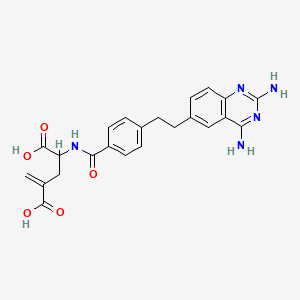

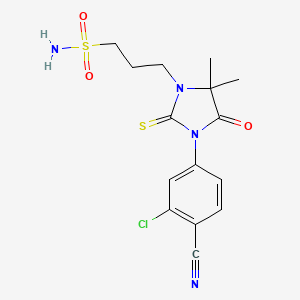
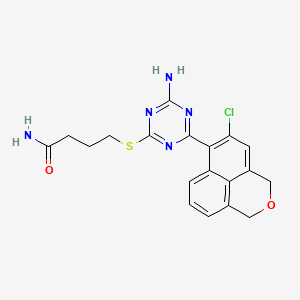

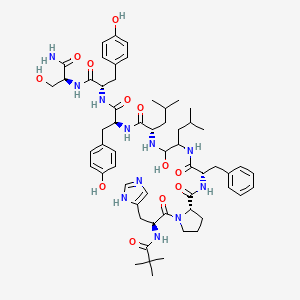
![4-[3-Oxo-3-(5,5,8,8-tetramethyl-5,6,7,8-tetrahydro-naphthalen-2-YL)-propenyl]-benzoic acid](/img/structure/B1668566.png)
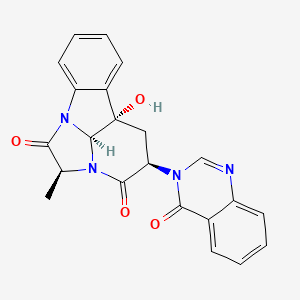
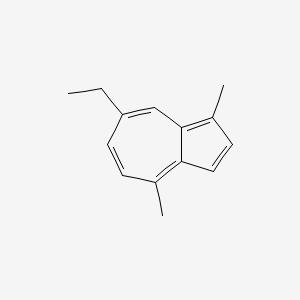
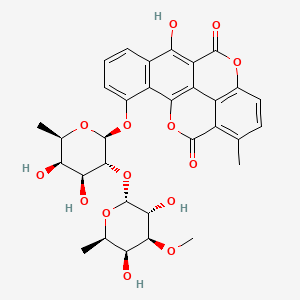
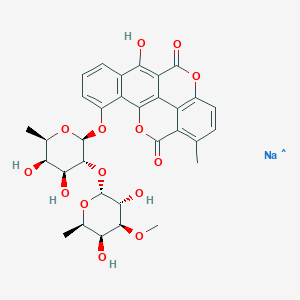
![2-[(4R,5S,7R,8R,11S,12S,13S,21S)-13,17,18-trihydroxy-2,10,14-trioxo-5,21-bis[(3,4,5-trihydroxybenzoyl)oxy]-7-[(3,4,5-trihydroxybenzoyl)oxymethyl]-3,6,9,15-tetraoxatetracyclo[10.7.1.14,8.016,20]henicosa-1(19),16(20),17-trien-11-yl]acetic acid](/img/structure/B1668574.png)
